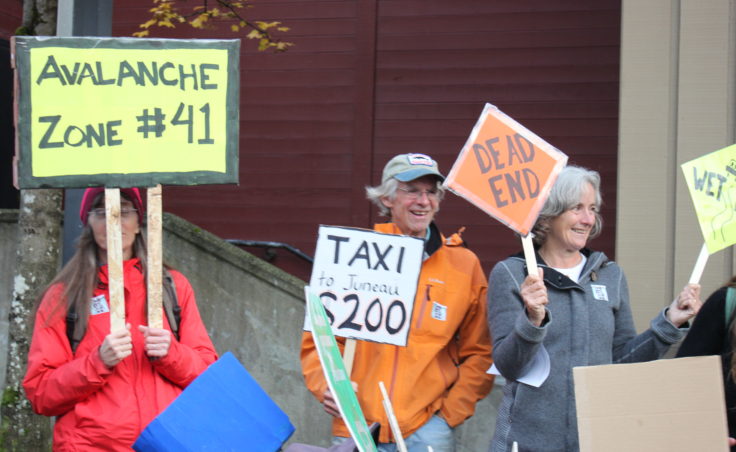At a public hearing last night in Juneau, locals spoke out nearly 4-to-1 against transportation officials’ effort to extend the capital city’s main road 48 miles farther north.
More than 50 people testified on the latest version of a federally required environmental impact statement for the Juneau Access Improvements Project.
Mendenhall Valley resident Brandee Gerke summed up many of the opponents’ key concerns about the road-building option that transportation officials have favored for years.
“Perceived convenience is being prioritized over cost and safety,” she said.
Juneau Access Project Open Houses
Tuesday’s open house was the first in a series the Alaska Department of Transportation & Public Facilities is holding to present the draft supplemental environmental impact statement and solicit public comment.
Haines, Oct. 15 at Chilkat Center for the Arts
Open House: 3 p.m.
Public Hearing: 6 p.m.
Skagway, Oct. 23 at Skagway High School
Open House: 3 p.m.
Public Hearing: 6 p.m.
Comments can also be submitted through Nov. 10 on the department’s website, via email to juneauaccess@alaska.gov, or regular mail:
Juneau Access Improvements Project
Attn: Deborah Holman
DOT&PF Southeast Region
P.O. Box 112506
Juneau, AK 99811-2506
Highway construction along the east side of Lynn Canal is estimated to cost $523 million. The new road would end at the Katzehin River where a new ferry terminal would make short connections to Haines, Skagway and the road system. The new terminal and ferries are estimated at another $51 million.
According to the EIS, the plan would also drive up the state Transportation Department’s operations and maintenance costs by about 30 percent compared to the status quo.
On safety, the document projects about 22 crashes per year on the new road and about one traffic death every six years, based on statewide data from similar roads.
But the safety concern folks repeatedly cited was avalanches. The proposed road crosses 41 avalanche paths.
“The fear of the road would probably eliminate a lot of people’s actual access out of as well as to Juneau,” said Larri Spengler, who lives on the avalanche prone Thane Road.
“Do we want our children on their school buses driving up that road to a ferry terminal? I’d much rather put them on the ferry in Auke Bay.”
The high risk would be driven down through engineering, explosive avalanche control and simply closing the road when avalanche risk is highest – forecast at about 12 days a year. Motorists would still face moderate avalanche risk, though; more than on Thane Road, but less than on Seward Highway, according to an avalanche risk index in the EIS.
Juneau Mayor Merrill Sanford, speaking for himself, ticked off what the upside would be.
“To be able to transport 10 times the number of vehicles, provide 5 to 7 times the number of ferry trips per week, cut travel time in half or more, and cut traveler cost up to 75 percent,” Sanford said.
And he added, 3 to 5 years of construction jobs.
Wayne Jensen said it’s incumbent on Juneau as a capital city to support the road and improve access for other Alaskans. Enhancing Juneau as a capital city is the mission of the nonprofit Alaska Committee that he chairs.
Another common thread in opponents’ testimony was skepticism toward cost estimates and traffic projections in the 694-page EIS. A few people even made outright accusations that officials cooked the books.
That wasn’t exactly what project manager Gary Hogins said he’d be listening for.
“Federal Highways and the department will respond to all comments, but the comments that are most helpful to us is constructive—did we make a mistake? Is there a gap in our information? You know, that sort of thing,” Hogins said before the hearing.
Tim Haugh is the environmental program manager for the Alaska division of the Federal Highway Administration. His agency would pay for much of the capital cost of the project and has the final say in which option is greenlit. He said the selection is based on “a balanced analysis of the transportation need with the environmental impacts, be they social, economic or natural.”
He said building the road best serves the overall public interest while improving transportation. At this stage, he said politics aren’t a factor.
The public comments will become part of the Federal Highway Administration’s record and may lead to revisions in the final version of the EIS, expected next fall.

